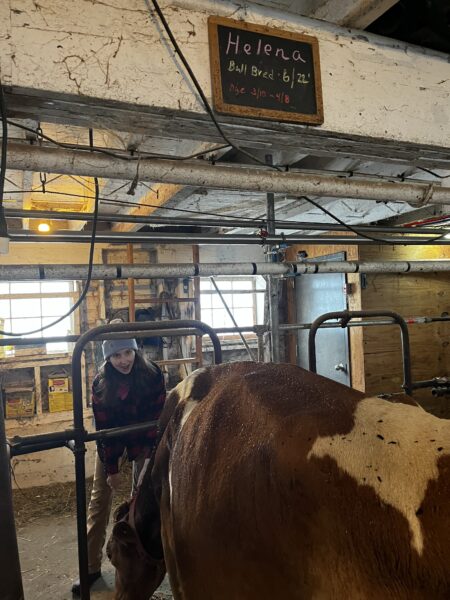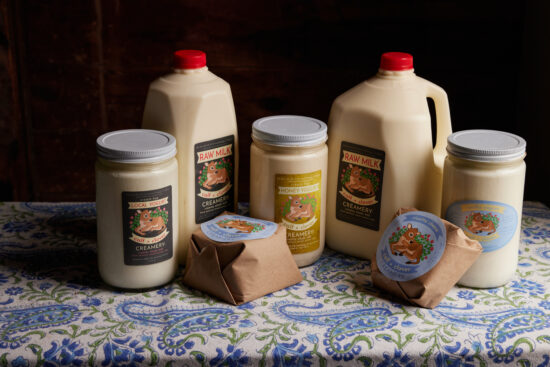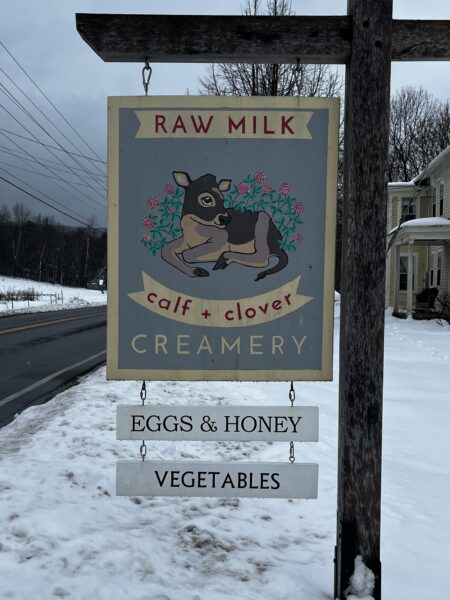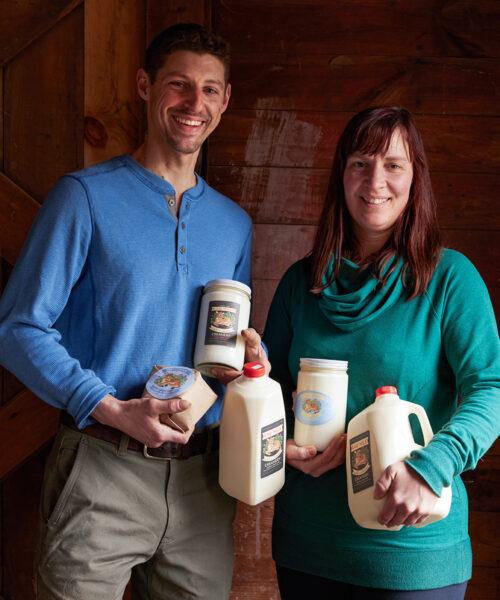February 26, 2024
Real Milk, Raw Milk
By Michelle Madden
Photos by Ryan Lavine
The workers at Calf & Clover Creamery in Cornwall go beyond standard hospitality. Molly gives me a gentle smile, Helena licks my hand, and Starlight nuzzles my leg before resuming their lunch of fermented alfalfa and clover. Greetings complete, the “ladies” stride into the barn, find their name printed on individual chalkboards hanging over their stall—reminiscent of a preschool classroom—and milking begins. Molly, Helena, and Starlight are part of a 20-cow herd (Jersey and Normande breeds) that bring raw milk to hundreds of uncompromising customers who stop by the farm 365 days a year, sunrise to sunset, to get what owners Sarah and Jeff Casel describe as, “One of the healthiest foods available.”

Why this almost cult-like devotion to raw milk?
We don’t usually think of milk as a processed food, especially whole milk—which by its very name suggests it’s, well, whole, meaning what-came-with-it-stays-with-it. But most milk does undergo “processing” either through homogenization, pasteurization, or both.

Whole milk must be at least 3.25 percent butterfat. (Commercial outfits have no incentive to make it higher, as the money’s in the cream.) So before commercial milk becomes whole milk, it first becomes skim milk. Homogenization strips out fat molecules, spins them to render them small enough to remain suspended, and then returns them to the milk to achieve the desired fat percentage. Along with the fat, fat-soluble vitamins A and D are removed and often added back (in synthetic form) to meet required levels.

Pasteurization, which all non-raw milk undergoes, is the process of killing most of the bacteria to reduce the risk of pathogen growth. (Ultra-pasteurization destroys all bacteria and inactivates most nutrients, rendering the milk essentially inert in order to extend the shelf-life upward of three months.) As Felice Martin, the owner of Nature View Farm in Bridgewater, puts it, “Pasteurized milk is dead milk. With raw milk, the probiotics, enzymes, minerals, and vitamins are in their natural state.”

Raw milk is neither pasteurized nor homogenized. Everything it came with, it stays with. It often has higher milk fat, exceeding four or even five percent (due to the breeds more often used for raw milk and a largely grass diet) resulting in a creamier taste and often higher, naturally occurring, Vitamin A and D. “Good fats are good for you,” states Rick Plumb, the owner of Meadow Ridge Farm who sells raw milk in Litchfield. Science is now proving that the prior warning against saturated fats was overly simplistic. The message that whole fat foods might actually be good for you is slowly seeping into consciousness.
Many consumers report significant health benefits from raw milk, noting everything from a reduction of eczema to the elimination of GI problems. Casel feels strongly that the act of reducing the natural size of the fat molecules (through homogenization), means that lactose—the sugar in milk—gets absorbed too quickly by the gut, leading to bloating and other digestion issues. Perhaps too, it’s the bacteria that’s playing a role. “Milk is not inherently full of bad bacteria,” says Casel. “The bacteria actually has an important role to play in its digestibility.” Some even believe that raw milk, with abundant healthy bacteria, is an immune booster.

Sales appear to back this up. All three farms report soaring growth with Calf & Clover selling 250 gallons to consumers weekly. Every customer has their reason: for some it’s health; for others it’s the desire to connect to the source. I can say, it’s hard not to meet Nutmeg, as she grazes in the Litchfield hills, letting out contented steamy breaths, and feel that what she is producing is perfect—just the way it is. —calfandclovercreamery.com

Local raw milk is available here:
Calf & Clover, 332 Kent Rd. S, Cornwall Bridge
Meadow Ridge, 277 Beach St., Litchfield
Nature View, 59 Second Hill Rd., Bridgewater






















